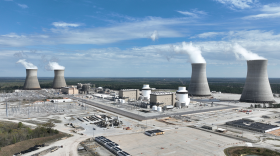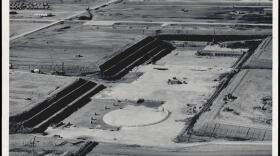The land in Piatt County in central Illinois is flat, and it’s easy to see for miles around Jerry Edwards’ house in a rural area north of Mansfield. In a few months, his view will include a wind farm, with two wind turbines close by.
“There will be a tower the size of the Gateway Arch back this way in where the green cover crop is,” Edwards said. “And then in the field, just east of it … there will be a second right out a mile from here.”
Edwards, who is the vice chairman of the Piatt County Board, was among those who voted down the project in March 2023. Then, just seven months later, the board reversed course and approved the Prosperity Wind Project in a 4-2 vote.

While Edwards voted no both times, he said that on the second vote, his fellow board members felt they had no choice but to approve the Apex Clean Energy project, which will bring up to 50 wind turbines over 20,000 acres of farmland across two townships.
That’s because of a new law passed by the Illinois General Assembly last year, setting statewide standards for wind and solar projects.
“In a nutshell, the governor, the Speaker of the House, and the head of the Senate basically had a gun held to their head, saying you are going to vote for this,” Edwards said, “or else you subjected the county to lawsuits that would break the county.”
Across the Midwest a tug of war is taking place over renewable energy projects, like the one in Piatt County.
In Iowa, Woodbury County all but eliminated the possibility of wind projects by increasing setbacks for turbines. The town of New Bloomfield, Missouri, adopted regulations barring solar farms within 1,000 feet of the city limits. In Buffalo County, Nebraska, commissioners unanimously voted for restrictions that require wind turbines be at least 3 miles from any dwelling and 5 miles from a town.
But Illinois and Michigan are pushing back, with new laws that make it hard for local governments to say no to green projects.
Illinois Gov. JB Pritzker signed the legislation in January, 2023 blocking outright bans on wind and solar projects by local governments. Northern Illinois University law professor Sarah Fox, whose specialty is the intersection of environmental law, property and land use, said the state needs more wind and solar farms in order to meet its goal of 100% clean energy by 2050.
“If you have local governments around the state, unwilling to commit to wind and solar and other things, then Illinois is not going to be able to get to those renewable energy goals that it set,” Fox said.

In Michigan, the state’s Clean Energy Future legislation, signed by Gov. Gretchen Whitmer last November, includes a provision that moves final authority for the permitting of large-scale renewable energy projects over to the Michigan Public Service Commission. Before that, such decisions were decided at the local township level.
A notable example is Montcalm County. In 2022, voters in four townships rejected referendums that would have allowed four wind turbine projects and one solar farm. Besides rejecting the wind and solar projects, voters also recalled township officials who had supported them.
Once Michigan’s new Clean Energy Future legislation takes effect this November, such referendums will have no effect. Laura Sherman, president of the Michigan Energy Innovation Business Council, predicts the new laws will do good things for her state’s environment, as well as its economy.
“This is going to open up the market, cut red tape, reduce restrictions for businesses, create jobs, and enhance economic opportunities,” Sherman said.
Yet there’s already an effort to overturn portions of the law. Retired Michigan school teacher Norm Stephens is collecting petition signatures for a November referendum to overturn the state Public Service Commission’s new authority.
“The state’s plans of 100% renewable energy and takeover of local control of that zoning is a classic case of government overreach,” said Stephens, “and they aren’t realistic, nor are they achievable.”
Growing opposition
Wind turbines and solar panels are built on sites leased by willing landowners, some of whom say the resulting revenue is crucial to be able to keep their farmland. But local opposition to wind and solar by the neighbors of those sites has been growing year by year, according to the Sabin Center for Climate Change Law at Columbia University in New York.
The center has kept track of the opposition for the last three years, through an annual report. As of last year, the center counted nearly 300 projects that have faced serious opposition, and at least 228 local governments that either place onerous restrictions on wind and solar projects or ban them outright. The report calculates the number of challenged projects increased 39% and the number of local restrictions increased by 35% during the period of March 2022 to May 2023.
“I think this is largely due to the fact that developers are proposing projects in new areas,” said Matthew Eisenson, who authored the 2023 edition of the report. “And these local restrictions are often a reaction to a specific project proposal.”

The number of wind and solar facilities in the U.S. has grown over the years, as costs for the technology have fallen. Eisenson said there was a notable market response, as the price of building and installing wind and solar energy facilities fell in the early 2000s.
“The expectation was that we would need a carbon tax or cap and trade system, which can be politically very difficult,” said Eisenson. “But the economics of wind and solar have just improved so dramatically that these projects really are getting built at scale.”
And supporters of renewable energy think opponents of big wind and solar projects. will come around in time.
Jeff Danielson is vice president of advocacy with the Clean Grid Alliance, which advocates for renewable energy in the Midwest. He believes conversion to wind and solar energy will arrive, even in areas where it now faces opposition.
“But it will come with some discussion, some conflict, and a reconciling of folks’ preferences along the way,” said Danielson. “We should embrace that because we get to do it in a democratic setting. And that, I think, should be everybody’s goal.”
Danielson said communities tend to respond more positively to wind and solar projects, once they’re up and running.
But back in Piatt County, Jerry Edwards remains unconvinced about having wind turbines as neighbors and unhappy about state laws that override local authority regarding where big wind and solar projects are built.
“I just want to stress the fact that the Piatt County Board was not in favor of this,” Edwards said. “No one on the county board wanted to vote for this.”
This story was produced in partnership with Harvest Public Media, a collaboration of public media newsrooms in the Midwest. It reports on food systems, agriculture and rural issues.
Copyright 2024 KCUR 89.3. To see more, visit KCUR 89.3. 9(MDA4OTAxNzAzMDEzMjc0MTc2MzA5ZDZlMw004))






